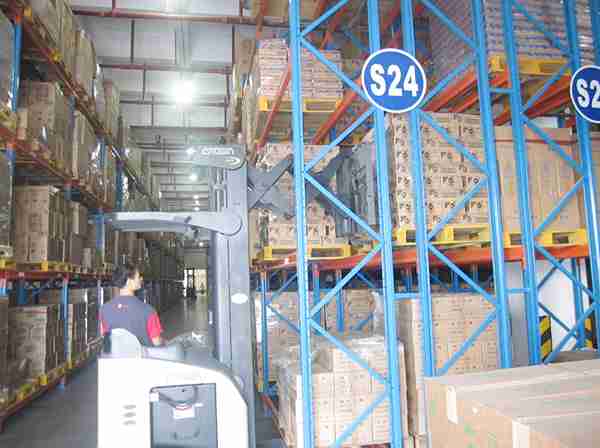📐 "First 50 Enterprise Queries Get Custom 3D Warehouse Design" Plan

Introduction: The Critical Role of Double Deep Racking in Modern Food Warehousing
The food industry operates on razor-thin margins where storage efficiency directly impacts profitability. With rising real estate costs and increasing SKU complexity, double deep racking for food industry applications has become a must-have solution for distributors, cold storage operators, and large-scale food manufacturers.
Unlike traditional single-deep systems, double deep racking for food industry warehouses doubles storage capacity while maintaining accessibility—making it the gold standard for businesses needing high-density storage without sacrificing operational speed.
This guide dives deep into why double deep racking for food industry storage is revolutionizing warehouses worldwide, how it outperforms other systems, and what food businesses must know before implementation.

H1: What Makes Double Deep Racking for Food Industry Storage So Effective?
H2: The Science Behind High-Density Food Storage
Double deep racking for food industry operations works by storing two pallets deep instead of one, effectively cutting aisle space by 50%. This design is particularly beneficial for:
- Perishable goods (frozen foods, dairy, fresh produce)
- Beverage distributors (high-volume SKUs like cans and bottles)
- Dry grocery warehouses (cereals, canned goods, packaged foods)
H2: Key Advantages Over Single-Deep & Drive-In Systems
| Feature | Double Deep Racking for Food Industry | Single Deep Racking | Drive-In Racking |
|---|---|---|---|
| Storage Density | ✅ High (40% more than single-deep) | ❌ Low | ✅ Very High |
| Accessibility | ✅ Medium (FIFO possible) | ✅ High (direct access) | ❌ Low (LIFO only) |
| Forklift Requirements | Extended-reach | Standard | Standard |
| Best For | Fast-moving food inventory | Small operations | Bulk non-perishables |
Why food businesses choose double deep racking:
✔ More pallets per square foot = lower storage costs
✔ Better space utilization in refrigerated warehouses
✔ Faster picking than drive-in systems
H1: Optimizing Cold Storage with Double Deep Racking for Food Industry
H2: How Frozen & Refrigerated Warehouses Benefit
Cold storage facilities lose $1.50 per square foot annually in wasted space. Double deep racking for food industry cold storage slashes costs by:
- Reducing air loss (fewer aisles = less cold air escape)
- Increasing storage density (more pallets per refrigeration unit)
- Supporting FIFO inventory (critical for perishables)
Case Study: A Midwest frozen pizza distributor increased capacity by 35% after switching to double deep racking for food industry cold storage.
H2: Special Considerations for Cold Environments
- Galvanized steel frames prevent rust in high humidity
- Anti-slip pallet supports for icy conditions
- Seismic bracing for tall, heavy loads
H1: Designing the Perfect Double Deep Racking System for Food Warehouses
H2: Structural Engineering Must-Knows
- Beam Load Ratings: Must exceed 5,000 lbs per pair for canned goods
- Upright Frame Spacing: Typically 8-10 ft on-center
- Decking Options: Wire mesh (ventilation) vs. solid steel (small items)
H2: Forklift Compatibility & Training
⚠ Standard forklifts won’t work—double deep racking for food industry requires:
- Extended-reach forklifts (144″ forks minimum)
- Narrow-aisle trucks (for facilities under 30 ft ceiling height)
- Operator certification programs (25% fewer accidents post-training)
H1: Real-World Success Stories: Double Deep Racking for Food Industry Leaders
H2: National Beverage Distributor Cuts Costs by 22%
After implementing double deep racking for food industry beverage storage:
📈 18% more cases per aisle
📉 Reduced forklift fuel costs (fewer travel lanes)
H2: Organic Produce Supplier Doubles Capacity
By converting to double deep racking for food industry fresh produce:
🚜 FIFO-compatible layouts reduced spoilage
📦 Same building stored 2x more pallets
H1: Future-Proofing Food Warehouses with Advanced Double Deep Solutions
H2: The Rise of Automated Double Deep AS/RS
New automated storage and retrieval systems (AS/RS) now integrate with double deep racking for food industry, featuring:
- Robotic pallet retrievers (no forklifts needed)
- AI-powered slotting optimization
H2: Sustainability Trends in Food Industry Racking
- Recycled steel racking (85% less carbon footprint)
- Solar-compatible warehouse designs
Conclusion: Is Double Deep Racking the Right Choice for Your Food Business?
For any food company storing 50+ pallets daily, double deep racking for food industry delivers unmatched ROI through:
✅ Higher storage density
✅ Lower operational costs
✅ Improved inventory control
Next Steps:
- Calculate your space savings with a racking specialist
- Test extended-reach forklifts in your facility
- Phase implementation to minimize downtime
FAQs
1. How much does double deep racking for food industry installation cost?
Average 40 per square foot—far cheaper than warehouse expansion.
2. Can I retrofit my existing food warehouse with double deep racking?
Yes, most facilities convert in 2-3 weeks with minimal disruption.
3. What’s the maximum weight capacity for double deep racking?
Up to 48,000 lbs per bay when properly engineered.
4. How does double deep racking improve food safety?
- Better airflow than drive-in systems
- Easier pest control inspections
5. What food products shouldn’t use double deep racking?
❌ Oversized pallets exceeding 48″ depth
❌ Fragile glass containers (unless stabilized)




